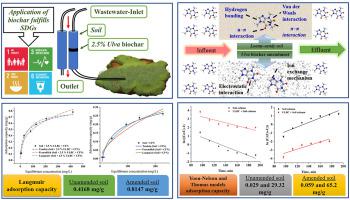Journal of Environmental Management ( IF 8.0 ) Pub Date : 2021-01-01 , DOI: 10.1016/j.jenvman.2020.111852 S. Keerthanan , Chaminda Gunawardane , Thiruchenduran Somasundaram , Tharuka Jayampathi , Chamila Jayasinghe , Meththika Vithanage

|
The goal of the present study was to evaluate the immobilization and retention of caffeine (CFN) in soil and the influence of biochar for the CFN transport in agricultural soil. The biochar was produced from the Ulva reticulata seaweed biomass (ULBC) under the slow-pyrolysis with a heating rate of 7 °C/min at 500 °C and characterized using XRD and FTIR. The CFN retention and transport abilities in loamy sand and ULBC amended (2.5%) soil were evaluated under various pH values range of 3–10 and at various CFN concentrations using batch and column experiments. The surface orientation of ULBC was portrayed as the randomized distribution of hetero and homogeneous nature. The highest retention capacity (40 μg/g) was obtained at pH 4.0. Soil amendment with ULBC shows a higher retention affinity towards CFN, of up to 150 μg/g than soil, with minimal pH dependence. The maximum CFN adsorption capacities of soil and amended soils were 420 and 820 μg/g, respectively, based on the Langmuir model. Batch experiments suggested the adsorption of CFN by the biochar amended loamy soil is governed by the electrostatic attraction. The column experiment data demonstrated a high transport potential of CFN in the loamy sand; however, a strong cumulative reduction of transport (58%) was observed with the application of ULBC into the loamy sand. Thus, the addition of seaweed biochar as an amendment in soils with biosolids and wastewater irrigation may reduce the mobilization of CFN to the aquatic system and possibly reduce plant uptake.
中文翻译:

固定化和土壤中的咖啡因保留修改与石莼马丁生物炭
本研究的目的是评估咖啡因(CFN)在土壤中的固定和保留以及生物炭对CFN在农业土壤中运输的影响。生物炭是由网状Ulva产生的在500°C下以7°C / min的升温速率缓慢热解的海藻生物质(ULBC),并使用XRD和FTIR进行表征。使用批处理和色谱柱实验,在3-10的各种pH值和各种CFN浓度下,评估了壤土和ULBC改良土壤(2.5%)中CFN的保留和迁移能力。ULBC的表面取向描绘为异质和均质性质的随机分布。在pH 4.0下获得最高的保留容量(40μg/ g)。使用ULBC的土壤改良剂对CFN的保留亲和力比土壤高,高达150μg/ g,对pH的依赖性最小。根据Langmuir模型,土壤和改良土壤的最大CFN吸附容量分别为420和820μg/ g。分批实验表明,生物炭改良的壤土对CFN的吸附受静电吸引的控制。柱实验数据表明,CFN在壤土中具有很高的运输潜力。然而,将ULBC施用到壤土砂中后,观察到运输的累积累积量大大降低(58%)。因此,在生物固体和废水灌溉的土壤中添加紫菜生物炭作为改良剂可能会减少CFN向水生系统的迁移,并可能减少植物的吸收。











































 京公网安备 11010802027423号
京公网安备 11010802027423号